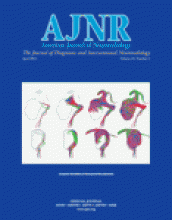Abstract
BACKGROUND AND PURPOSE: Our purpose was to describe the CT and MR features of intracranial aneurysms occluded with the liquid polymer Onyx.
METHODS: At two centers, 35 aneurysms in 33 patients and 11 in nine patients were treated with the polymer. In 17 patients, adjunctive stents were placed at the aneurysm neck. All but three aneurysms originated from the internal carotid artery (ICA). Eighteen were giant; 15, large; and 13, small. Patients underwent pre- and postprocedural CT and/or MR imaging; MR angiograms (MRAs) were available in 22. In 35 patients (38 aneurysms), 3-month and/or 1-year follow-up angiograms were obtained for correlation with sectional images.
RESULTS: Except in two small aneurysms, polymer filling created beam hardening artifacts on CT scans. In 10 aneurysms, the polymer did not fill the aneurysm sac entirely; five showed recanalization at follow-up. On MR images (all sequences), the polymer appeared hypointense, probably because of its tantalum content; it did not create artifacts. MRAs falsely suggested reduced or absent ICA flow in 11 of 22 patients, nine of whom with stents. In the rest, MRA provided results comparable to those of selective angiography. In 12 patients, postprocedural imaging revealed new lesions.
CONCLUSION: Onyx appears hypointense on MR images, with no artifact, and it does not interfere with MRA except in patients with stents. MR imaging may reveal new parenchymal lesions, even in asymptomatic patients. In the immediate control and follow-up of polymer-treated aneurysms, MR imaging and MRA may be preferred. CT may show the degree of filling in the aneurysmal sac, but Onyx creates artifacts that hinder CT evaluation.
- Copyright © American Society of Neuroradiology












